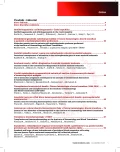-
Medical journals
- Career
Use of molecular cytogenetic techniques in the analysis of chromosomal aberrations in haematological malignancies
Authors: J. Březinová 1; I. Šárová 1; Š. Ransdorfová 1; Z. Zemanová 2; K. Michalová 1,2
Authors‘ workplace: Ústav hematologie a krevní transfuze, Praha 1; Centrum nádorové cytogenetiky, Ústav lékařské biochemie a laboratorní diagnostiky VFN a 1. LF UK, Praha 2
Published in: Transfuze Hematol. dnes,23, 2017, No. Supplementum1, p. 48-53.
Category:
Overview
Cytogenetic analysis of bone marrow cells is one of the basic examinations performed in patients with malignant haematological diseases. It helps specify the diagnosis and provides valuable information regarding disease prognosis. Detection of chromosomal aberrations is limited by the method’s resolution and thus more sensitive molecular cytogenetic techniques, based on fluorescence in situ hybridization, are used. These allow rapid and accurate analysis of numerical and structural aberrations, detection of cryptic chromosomal rearrangements, exact determination of breakpoints and identification of altered genes. Various modifications of molecular cytogenetic techniques are used both in routine laboratory practice as well as for research purposes. These can help detect minimal residual disease, monitor benign proliferation or eventual clonal evolution and assess treatment success. New insights into molecular changes contribute to a better understanding of pathogenesis, to the stratification of patients for targeted therapy and to the detection of other genetic mechanisms behind the origin and development of the leukaemic clone.
KEY WORDS:
classical cytogenetic analysis – FISH – leukaemia – preleukaemia
Sources
1. Greenberg P, Cox C, LeBeau MM, et al. International scoring system for evaluating prognosis in myelodysplastic syndromes. Blood 1997;89 : 2079–2088.
2. Greenberg PL, Tuechler H, Schanz J, et al. Revised international prognostic scoring system for myelodysplastic syndromes. Blood 2012;120 : 2454–2465.
3. Grimwade D, Walker H, Oliver F, et al. The importance of diagnostic cytogenetics on outcome in AML: analysis of 1,612 patients entered into the MRC AML 10 trial. The Medical Research Council Adult and Children‘s Leukaemia Working Parties. Blood 1998;92 : 2322–2333.
4. Grimwade D, Hills RK, Moorman AV, et al. Refinement of cytogenetic classification in acute myeloid leukemia: determination of prognostic significance of rare recurring chromosomal abnormalities among 5876 younger adult patients treated in the United Kingdom Medical Research Council trials. Blood 2010;116 : 354–365.
5. Michalová K, Zemanová Z. Molekulární cytogenetika v diagnostice nádorových onemocnění. Cas Lek Ces 2006;145 : 532–537.
6. Pinkel D, Straume T, Gray JW. Cytogenetic analysis using quantitative, high-sensitivity, fluorescence hybridization. Proc Natl Acad Sci U S A 1986;83 : 2934–2938.
7. Fan YS, Davis LM, Shows TB. Mapping small DNA sequences by fluorescence in situ hybridization directly on banded metaphase chromosomes. Proc Natl Acad Sci USA 1990;87 : 223–227.
8. Michalová K, Lemez P, Bartsch O, et al. Derivative (6)t(1;6)(q22;p21) revealed in bone marrow cells by FISH 9 months before diagnosis of acute T-lymphoblastic leukemia. Cancer Genet Cytogenet 1996;86 : 131–135.
9. Ransdorfová Š, Březinová J, Šárová I, et al. Využití interfázní fluorescenční in situ hybridizace pro analýzu CD34+ buněk v periferní krvi u nemocných s myelodysplastickými syndromy. Transfuze Hematol dnes 2016;22 : 90–96.
10. Brezinová J, Zemanová Z, Cermák J, Michalová K. Fluorescence in situ hybridization confirmation of 5q deletions in patients with hematological malignancies. Cancer Genet Cytogenet 2000;117 : 45–49.
11. Zemanova Z, Michalova K, Buryova H, et al. Involvement of deleted chromosome 5 in complex chromosomal aberrations in newly diagnosed myelodysplastic syndromes (MDS) is correlated with extremely adverse prognosis. Leukemia Res 2014;38 : 537–544.
12. Kloosterman WP, Guryev V, van Roosmalen M, et al. Chromothripsis as a mechanism driving complex de novo structural rearrangements in the germline. Hum Mol Genet 2011;20 : 1916–1924.
13. Stephens PJ, Greenman CD, Fu B, et al. Massive genomic rearrangement acquired in a single catastrophic event during cancer development. Cell 2011;144 : 27–40.
14. Brezinova J, Sarova I, Buryova H, et al. Fusion of the additional sex combs like 1 and teashirt zinc finger homeobox 2 genes resulting from ider(20q) aberration in a patient with myelodysplastic syndrome. Br J Haematol 2014;164 : 153–155.
15. MacKinnon RN, Campbell LJ. The role of dicentric chromosome formation and secondary centromere deletion in the evolution of myeloid malignancy. Genet Res Int 2011;2011 : 643628.
16. Sarova I, Brezinova J, Zemanova Z, et al. Molecular cytogenetic analysis of dicentric chromosomes in acute myeloid leukemia. Leukemia Res 2016;43 : 51–57.
Labels
Haematology Internal medicine Clinical oncology
Article was published inTransfusion and Haematology Today

2017 Issue Supplementum1-
All articles in this issue
- Genetic tests for selecting haematopoietic stem cell donors and post-transplant monitoring
- Centre for rare disorders of haematopoiesis at the Institute of Haematology and Blood Transfusion
- Transfusion and immunohematology at the Institute of Haematology and Blood Transfusion
- Standard and large volume leukapheresis of peripheral blood progenitor cells using the new Spectra Optia continuous mononuclear cell collection protocol
- Dysfibrinogenaemia and afibrinogenaemia in the Czech Republic
- Molecular genetic tests in patients with myelodysplastic syndrome performed at the Institute of Haematology and Blood Transfusion
- Functional consequences of mutations in the nucleophosmin gene in acute myeloid leukaemia
- Current trends in the treatment and diagnostics of chronic myeloid leukaemia
- Use of molecular cytogenetic techniques in the analysis of chromosomal aberrations in haematological malignancies
- Haematopoietic cell transplantation at the Institute of Haematology and Blood Transfusion (1986–2016)
- Transfusion and Haematology Today
- Journal archive
- Current issue
- Online only
- About the journal
Most read in this issue- Dysfibrinogenaemia and afibrinogenaemia in the Czech Republic
- Centre for rare disorders of haematopoiesis at the Institute of Haematology and Blood Transfusion
- Transfusion and immunohematology at the Institute of Haematology and Blood Transfusion
- Functional consequences of mutations in the nucleophosmin gene in acute myeloid leukaemia
Login#ADS_BOTTOM_SCRIPTS#Forgotten passwordEnter the email address that you registered with. We will send you instructions on how to set a new password.
- Career

